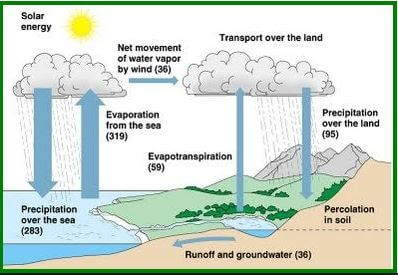The breeze, the blackish gray clouds, the roar of the sky is one of the features that rain will soon be. If you know how the rain is going, it's as simple as what we saw! Want to know what the rain process is like? Let's look at the full discussion below.
Rain is a formation of the precipitation process. Rain is also one of the processes of the hydrologic cycle.
Types of Rain
Apparently, the rain is many kinds! The various types of rain are caused by several different factors. There are 3 types of rain that occurred, namely frontal rain, orographic rain and zenith rain.
The process of rainfall in these three types is different:
Frontal rain occurs because of a meeting between summer winds that carry moisture and low-temperature air. Usually, the second meeting of the mass differences occurs in the front of the field, which is one of the places that will easily the process of condensation and formation of clouds.
Orographic rain occurs in mountainous areas or places with high altitudes. The process of occurrence of this rain is the presence of water vapor carried into the mountainous region met with a low-temperature air mass that occurs condensation and form clouds. After the clouds saturated, the rain fell.
Zenith rain or commonly known as convection rain. This rain happens around the equator! The convection of rain occurs because of a meeting of the north-east winds with the southeastern southeast winds that form a clump that rises vertically as it is exposed to warming by the sun. This causes the surrounding temperatures to drop and the cloud mass increases. Arriving at the saturation point, the rain went down.
Read a related article about: Sky is blue

The process of rain begins from the sun that brings heat energy causes the evaporation process. In the process of evaporation, water in the earth (the sea, lakes, rivers and other bodies of water) evaporates because the heat then produces water vapors. The moisture vapors are lifted into the air and condensed.
In the condensation process, the moisture vapors turn into moisture caused by the temperature around the water vapor is lower than the dew point. The higher air temperatures make the dots more and more dense and compact and form into clouds.
The existence of differences in air pressure in the sky causes the movement of air or commonly known by the wind. The wind moves clouds carrying water grains to places with lower temperatures. The collected clouds merge into large, gray clouds (a process called coalescence).
Now you're not surprised why if you want to rain a lot of wind and the sky is overcast? Then, the grains of water in the sky how can fall?
The answer is two! The First is because the condition of the cloud is saturated or in other words, is not able to hold water again. The second is that the grains of water are attracted by the force of gravity. Therefore the grains of the waterfall into the rain.
When the rainwater starts to fall to the ground, not all the waterfalls to the surface! Apparently, there is some water that evaporates back up into the clouds. Why so? Because the water penetrates the warmer layers of the atmosphere beneath it, there are several grains of water that evaporate. As long as water makes the cloud conditions saturated, then the rain will continue.
How? already understand how the process of rain?